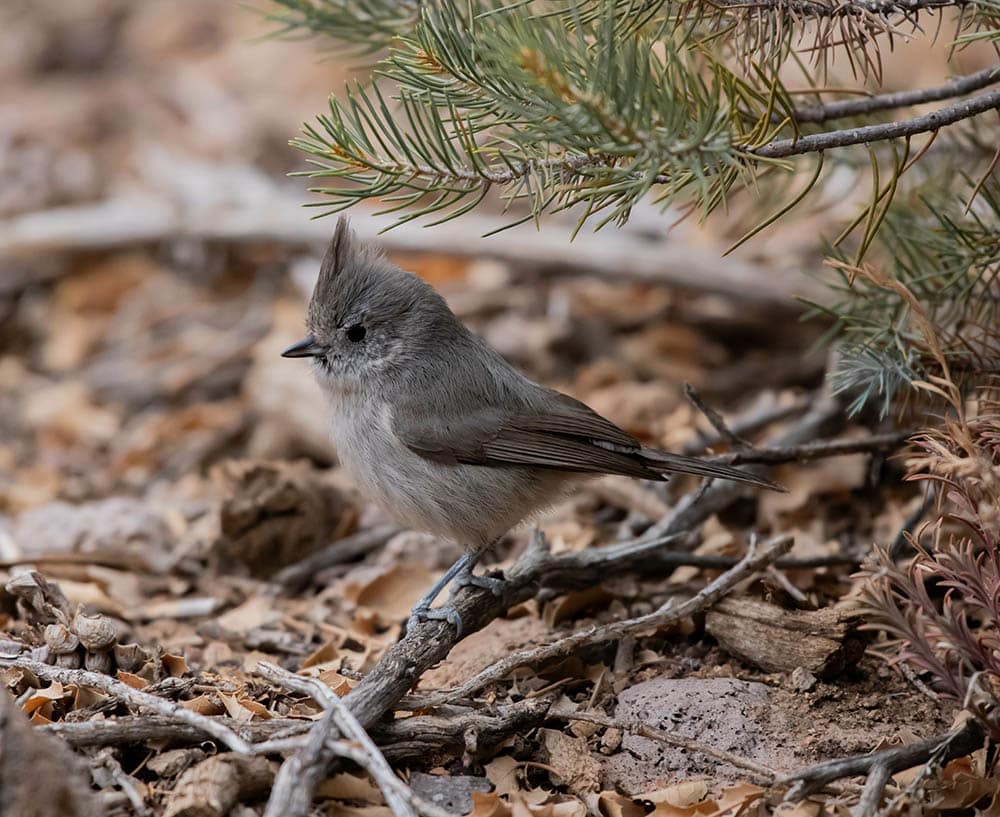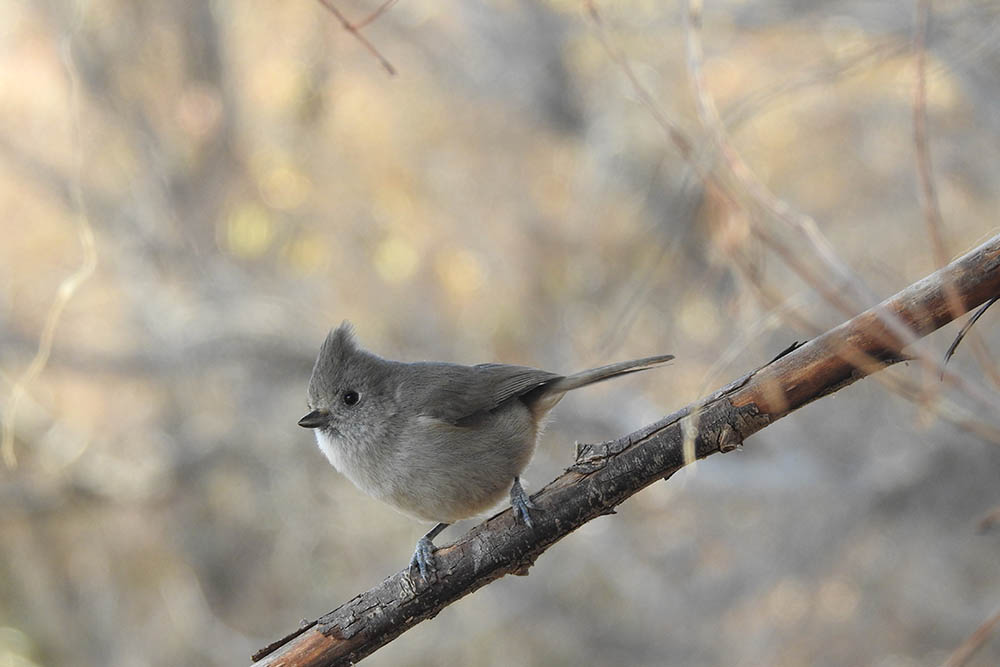Juniper Titmouse: Field Guide, Pictures, Habitat & Info
Last Updated on

The Juniper Titmouse is a part of the Paridae bird family. It has a tiny stature and is covered from head to toe with pale gray feathers. These birds have a distinctive tufted hood and short dark gray legs. They’re popular in southwestern states including Nevada, Texas, New Mexico, Utah, Colorado, and California. The Titmouse can often be seen hanging out on light twigs and branches searching for food.

Quick Facts About Juniper Titmouse
| Habitat: | Open or forest woodlands |
| Diet: | Insects, nuts, seeds |
| Behavior: | Sedentary, typical foragers |
| Nesting: | Tree cavities or similar |
| Conservation: | No |
| Scientific name: | Baeolophus ridgwayi |
| Lifespan: | 2 years |
Juniper Titmouse General Description
The Juniper Titmouse is an omnivorous bird that weighs anywhere from 0.3-0.8 ounces on average. It’s a small, gray-colored bird that ranges anywhere from 4 to 6 inches in length. These birds typically live about one and a half to two years.

Juniper Titmouse Range, Habitat, Behavior, Diet & Nesting
Habitat
You may find these small birds nestled under fallen twigs, around piles of foliage, beneath dead pine needles, or in empty tree cavities. They are year-round residents and will usually stay in the same location if they have easy access to food and water. Titmice prefer mixed-woodland areas with mild elevation and lots of shrubs (where they can nest).
Diet
The Juniper Titmouse eats mostly insects, including spiders, bugs, caterpillars, beetles, and animals small enough for them to catch. These birds love to munch on nuts, insects, and various types of seeds. You’ll also catch them munching on pinyon nuts, weed seeds, and acorns.

Behavior
These birds forage for food by climbing on the branches and larger twigs or hanging upside down to search for insects. They can hold nuts with their feet and will forage in large groups for protection from predators.
Nesting
Juniper Titmice nest in small cavities in trees, either man-made holes or old woodpecker cavities. They carefully line their nests with soft materials including shed feathers, animal hair, and grass. The eggs are laid by the female, who lays between 5-8 eggs a season. They also mate for life in most cases.
Both parents are responsible for raising the young after the eggs hatch, but the female is responsible for incubating them. Both parents will also search for food, though the males will typically guard the nest if the female is present. After about 16-18 days, the young birds leave the nest.
Song
The song of a Juniper Titmouse is a series of rapid, hollow whistled phrases — with phrases often called out in groups of three or four.

How to Find a Juniper Titmouse: Birdwatching Tips
What to Listen For
Whistle-like hollow chirps in short bursts of phrases.
What to Look For
The Juniper Titmouse can be found on the ground foraging for food. They are known for hanging upside down in trees or perched on shrub branches. Note that they can get a bit feisty during nesting periods and may be more territorial during this time.
When to Look
You can find them all throughout the year and during various parts of the day. If they are nesting, you may see them flying around on the ground looking for food to feed their young before the eggs hatch.

Attracting Juniper Titmouse to Your Backyard: Tips & Tricks
Due to their omnivorous diet, Titmice make for an easy bird to attract. They don’t need perches and are fairly sure-footed. To attract them, you can set out a feeder with openings large enough for the Titmouse’s beak.
It’s best to hang the feeder near a tree so they can have somewhere safe to go after obtaining their meal. And if possible, use a squirrel guard to prevent their food from being eaten by squirrels and other local wildlife.
Juniper Titmouse Conservation: Is This Bird Threatened?
Currently, the titmouse is not on national conservation lists as an endangered species. However, they may have decreased populations in New Mexico (their most populous state) for various reasons.

Final Thoughts
The Juniper Titmouse is a cheerful, small gray bird that’s common to the Great Basin area of the United States. They usually eat insects, nuts, and fruit, depending on what’s available. They are cavity nesters that can be seen hanging out on the branches of tall trees or hidden within small shrubs.
If you’re looking to attract them to your backyard, try setting out an open feeder near a tree or other area where they can hide from predators while they eat.
Featured Image Credit: Wirestock Creators, Shutterstock
Table of Contents
- Quick Facts About Juniper Titmouse
- Juniper Titmouse General Description
- Juniper Titmouse Range, Habitat, Behavior, Diet & Nesting
- How to Find a Juniper Titmouse: Birdwatching Tips
- Attracting Juniper Titmouse to Your Backyard: Tips & Tricks
- Juniper Titmouse Conservation: Is This Bird Threatened?
- Final Thoughts
About the Author Robert Sparks
Robert’s obsession with all things optical started early in life, when his optician father would bring home prototypes for Robert to play with. Nowadays, Robert is dedicated to helping others find the right optics for their needs. His hobbies include astronomy, astrophysics, and model building. Originally from Newark, NJ, he resides in Santa Fe, New Mexico, where the nighttime skies are filled with glittering stars.
Related Articles:
10 Types of Hummingbirds in Arkansas (With Pictures)
8 Types of Hummingbirds in Nebraska (With Pictures)
5 Types of Hummingbirds in Idaho (With Pictures)
3 Types of Hummingbirds in Mississippi (With Pictures)
8 Types of Hummingbirds in Kansas (With Pictures)
5 Types of Hummingbirds in West Virginia (With Pictures)
5 Types of Hummingbirds in Ohio (With Pictures)
Where Do Nuthatches Nest? Nuthatch Nesting Habits Explained
